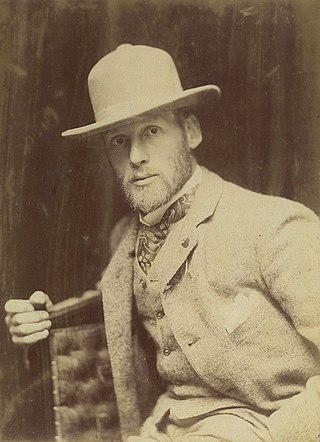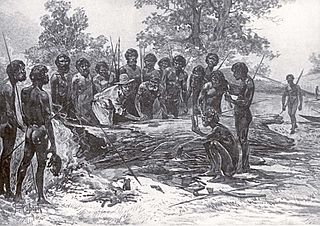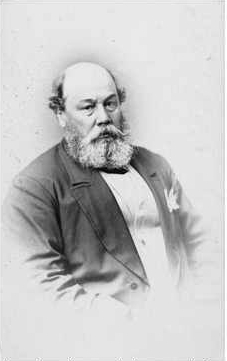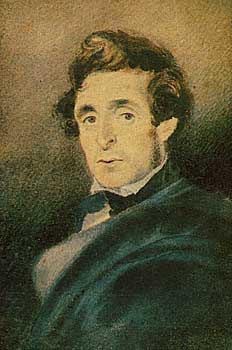This article includes a list of general references, but it lacks sufficient corresponding inline citations .(May 2024) |

Robert Hawker Dowling (1827 – 8 July 1886) was an Australian colonial artist.
This article includes a list of general references, but it lacks sufficient corresponding inline citations .(May 2024) |

Robert Hawker Dowling (1827 – 8 July 1886) was an Australian colonial artist.
Dowling was born in England the youngest son of Rev. Henry Dowling and his wife Elizabeth, née Darke. He was brought to Launceston, Tasmania with his parents in 1839 in the Janet. He received lessons from Thomas Bock and Frederick Strange, and in 1850 advertised as a portrait painter. In 1856 Dowling left for London partly with the help of friends in Launceston. He exhibited 16 pictures at the Royal Academy between 1859 and 1882 and others at the British Institute. Returning to Launceston he afterwards came to Melbourne and painted portraits of Sir Henry Loch, Dr James Moorhouse, Francis Ormond, and others. He went to London again in 1886 but died shortly after his arrival.
Dowling was a conscientious painter of figure subjects, often scriptural or eastern. He is represented in the Melbourne and Launceston galleries.
On 2 May 2007, one of Dowling's paintings – Masters George, William and Miss Harriet Ware with the Aborigine Jamie Ware – was bought for A$823,500 by the National Gallery of Victoria. [1] [2]

Sir Edwin Henry Landseer was an English painter and sculptor, well known for his paintings of animals – particularly horses, dogs, and stags. His best-known works are the lion sculptures at the base of Nelson's Column in Trafalgar Square.

Thomas William Roberts was an English-born Australian artist and a key member of the Heidelberg School art movement, also known as Australian impressionism.
Sir Thomas à Beckett was an Australian solicitor and judge.

Sir John Campbell Longstaff was an Australian painter, war artist and a five-time winner of the Archibald Prize for portraiture. Longstaff was one of the most prolific portraitists of the Edwardian period, painting many high society figures in both Australia and Britain.

Batman's Treaty was an agreement between John Batman, an Australian grazier, businessman and coloniser, and a group of Wurundjeri elders, for the purchase of land around Port Phillip, near the present site of Melbourne. The document came to be known as Batman's Treaty and is considered significant as it was the first and only documented time when Europeans negotiated their presence and occupation of Aboriginal lands directly with the traditional owners. The treaty was implicitly declared void on 26 August 1835 by the Governor of New South Wales, Richard Bourke.

Sir Arthur Blyth was Premier of South Australia three times; 1864–65, 1871–72 and 1873–75.
Girolamo Pieri Pecci Ballati Nerli, was an Italian-born painter who worked in Australia and New Zealand in the late 19th century, influencing the art scenes of both countries. In Australia, he is noted for influencing Charles Conder of the Heidelberg School movement, and in New Zealand, as an early teacher of Frances Hodgkins. His portrait of Robert Louis Stevenson in the Scottish National Portrait Gallery is usually considered the most searching portrayal of the writer.

Sir George Charles Hawker was a South Australian settler and politician.

Mount Elephant is a 380-metre-high (1,250 ft) conical breached scoria cone formed by a dormant volcano, located 1 km from the town of Derrinallum in southwestern Victoria, Australia. It is a prominent landmark that forms the eastern gateway to the Kanawinka Geopark from the Hamilton Highway at Derrinallum.
David Moore was an Australian photojournalist, historian of Australian photography, and initiator of the Australian Centre for Photography.

General Sir Thomas Simson Pratt, was a British Army officer. He served in the First Anglo-Chinese War (1839–1841), in India from 1843 to 1855 where he was deputy adjutant-general at Madras, and was commander of the British Forces in Australia from 1856 to 1861. He was promoted to lieutenant-general on 31 May 1865, and to full general eight years later.

Sir William Lambert Dobson was an English-born Australian politician, a Leader of the Opposition and Chief Justice of Tasmania, (Australia).

John Mather was a Scottish-Australian plein-air painter and etcher.
Norman James Brian Plomley regarded by some as one of the most respected and scholarly of Australian historians and, until his death, in Launceston, the doyen of Tasmanian Aboriginal scholarship.

William Buelow Gould was a painter born in the United Kingdom and later working in Van Diemen's Land. He was transported to Australia as a convict in 1827, after which he would become one of the most important early artists in the colony, despite never really separating himself from his life of crime.

Florence Ada Fuller was a South African-born Australian artist. Originally from Port Elizabeth, Fuller migrated as a child to Melbourne with her family. There she trained with her uncle Robert Hawker Dowling and teacher Jane Sutherland and took classes at the National Gallery of Victoria Art School, becoming a professional artist in the late 1880s. In 1892 she left Australia, travelling first to South Africa, where she met and painted for Cecil Rhodes, and then on to Europe. She lived and studied there for the subsequent decade, except for a return to South Africa in 1899 to paint a portrait of Rhodes. Between 1895 and 1904 her works were exhibited at the Paris Salon and London's Royal Academy.
Henry Dowling was a newspaper editor and politician in colonial Tasmania. He was the older brother of artist Robert Hawker Dowling.

Marie Anne Tuck, was an artist and art educator in South Australia.
Lucy Beeton was an Aboriginal Tasmanian schoolteacher, trader and Christian leader.

Douglas Thomas Kilburn was an English-born watercolour painter and professional daguerreotypist who operated in Melbourne 1847–49, producing some of the earliest portrait photographs of indigenous Australians.
Additional resources listed by the Australian Dictionary of Biography: